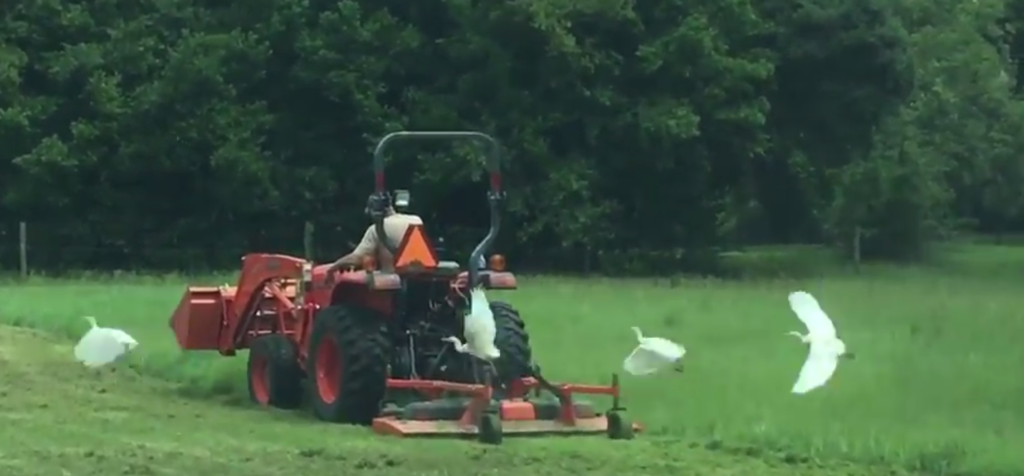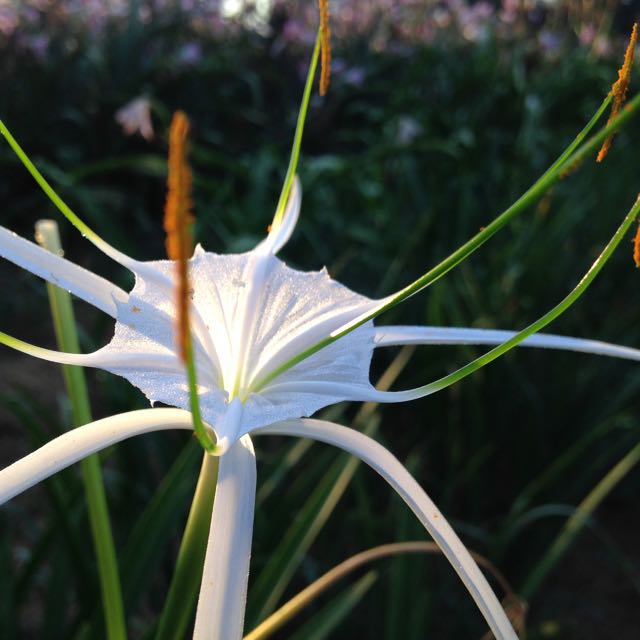
Ivory Elegance in August Weeding
Note; I’m working on a new book about daily life on the lily farm. Each short essay like this would be followed by an in-depth essay on the plants mentioned. I’d love your comments about this style of writing. And, there are pictures and video at the end but you may need to ‘View in Browser’.
Crouched down in the weeding position on a sweltering August day, I stood to stretch. A tiny swoon in my head and old eyes slowly focused the blurred scene beyond the fenced flower fields.
A sea of green pasture, Buck, the swayback, dirty old donkey stands belly deep in uncut grass. An orange tractor mows in straight lines, getting ready for wedding guests to park their cars tomorrow. Part of the pasture is still knee-tall Bermuda grass, but the part freshly cut by the tractor is walkable turf. Wedding-dress white egrets float above but a few of them tip toe on the ground with robotic movements.
Those egrets walk by pulling their bodies back a bit while heads thrust forward. Pointing, aiming, ready to lance their prey. They move like puppets or a lanky teenager learning to dance. It’s a stark contrast to their graceful flights. Every once in a while, I get a glimpse of silky feathers. These African cow egrets have the same ethereal feathers of their American cousins — feathers so desired for ladies hats, that Victorians almost caused their extinction.
Buck would be pristine-white except he likes to roll in a bare spot of the clay pasture. He’s off-orange. Presidential. Two lucky egrets perch on his back to get the right vantage point for hunting. But Buck is oblivious to his riders; he grazes slowly and methodically. Always. He’s a laid back vegetarian, the unwitting hunting perch for the military precision and constant motion of the egrets. Their sleek simple lines and purity of color belie a brutal appetite for mice and toads. As the tractor mows, little critters suddenly exposed, scamper and hop for cover. Egrets flock to hunt during mowing, stabbing a toad, tossing it up in the air, catching in and packing gullets full.
The bigger picture, the back-story that led to this moment is of decaying grass and weeds. Decay brings Life. Insects breed and grow in the duff. All that rot became insects. Insects become frogs and mice. Mice become egrets. Egrets become ladies hats and stylized icons on fountains. But the farm boy on the mower and the wedding guests who arrive tomorrow look straight ahead, toward a goal, not seeing the tiny connections of this August afternoon’s lesson.
I took in the scene for a moment then lean back to weeding. In August crab grass sprawls from a single point; it leans over, spreads and sort of floats over top of crinum leaves. So when I select the right stalk and pull, I get the satisfaction seeing a messy area cleared easily. One precise crab grass pull reveals an area the size of a card table suddenly clean and tidy. Satisfaction. In most place we leave the crab grass since it grows low. Soon enough it’s covered up by the sprawling black eyed pea vines. Peas, planted as a cover crop, thrive in August heat smothering low weeds. Pea vines make natural, green, free mulch. After frost, as the pea vines rot and roots break down, they add nitrogen to the soil and feed the insects.
But in this row, the flowers we like need to be weeded free of sprawling grass. Short and thin, spider lily leaves need exposure to sun. Earlier, in July, their beautifully curved, ivory white flowers stretched out of the green sea. They float above the crab grass and pea vine, almost drowned. They are the most elegant of our flowers. Individually, flowers unfurl slowly. Starting in the morning, a greenish white spear emerges, precisely pointed, like the egret’s beak, it’s made of petals twisted and fused. Slowly during the day, petals seem pressured, curling, getting ready to open. By evening, delicate petals make a cage with delicate curved bars. As the sun goes down, they unfurl. Their opening ought to be graceful, they should dance like Ginger Rogers.

Hymenocallis harrisiana flowers spread to 6 inches across but only 15 inches tall. It lives for decades so it’s a perfect bulb to inter-plant in liriope or other long term ground covers. This little Mexican native loves normal garden soil and tolerated ditches or that wet area where the air conditioner condenser pours out.
But like those elegant egrets with their herky-jerky hunting walk, spider lilies open with startling snaps. One petal here thrust out, another flicks over there. You have to be there at just the right moment to see it, the awkward robotic opening transform, in only a minute, to petals held upward in perfect symmetry, tiny yellow beacons at the center, fragrances released. Hunting, enticing all sort of night moths to land, to pollinate, to be a part of the bigger picture.
